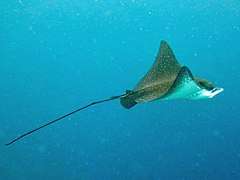Aetobatus
Aetobatus is a genus of eagle rays native to the Atlantic, Pacific and Indian Oceans.[2] It was formerly placed in Myliobatidae, but is now placed in its own family based on salient differences from myliobatids, especially the pectoral fins joining the head at the level of the eyes.[3]
| Aetobatus | |
|---|---|
.jpg) | |
| Aetobatus ocellatus in Fiji | |
| Scientific classification | |
| Kingdom: | |
| Phylum: | |
| Class: | |
| Order: | |
| Family: | Aetobatidae White & Naylor, 2016 |
| Genus: | Aetobatus Blainville, 1816 |
Species
There are currently 5 recognized extant species in this genus:
| Image | Common Name | Scientific name | Distribution |
|---|---|---|---|
 | Long-headed eagle ray[4] | Aetobatus flagellum (Bloch & J. G. Schneider, 1801) | Indo-West Pacific |
 | Pacific white-spotted eagle ray[5] | Aetobatus laticeps (T. N. Gill, 1865) | Baja California to northern Peru, including the Galápagos |
| Spotted eagle ray | Aetobatus narinari (Euphrasén, 1790) | Atlantic (including the Caribbean and Gulf of Mexico) | |
 | Naru eagle ray[6] | Aetobatus narutobiei W. T. White, Furumitsu, A. Yamaguchi, 2013 | northwest Pacific off south Japan, South Korea, China, Hong Kong and Vietnam |
 | Ocellated eagle ray[7] | Aetobatus ocellatus (Kuhl, 1823) | Indo-West Pacific |
There are also 6 extinct species (only known from fossil remains) placed in this genus:
- †Aetobatus arcuatus Agassiz 1843
- †Aetobatus cappettai Antunes & Balbino 2006
- †Aetobatus irregularis Agassiz 1843
- †Aetobatus punctatus Miller 1876
- †Aetobatus poeyi Fernández de Castro 1873
- †Aetobatus sinhaleyus Deraniyagala 1937
gollark: Yeees, I tend to alternate between thinking that I'm doing generally fine and thinking that I am not doing enough of [VARIOUS THINGS] and will utterly fail in some way.
gollark: Oh, go consume bees.
gollark: Anyway, potatOS now includes a high-performance* factorization engine using the Pollard rho algorithm, [DATA EXPUNGED], and the Rabin-Miller primality test.
gollark: How do you know about PotatOS Lightcycle? It's classified.
gollark: potato operation system.
References
| Wikimedia Commons has media related to Aetobatus. |
- Sepkoski, J. (2002). "A compendium of fossil marine animal genera (Chondrichthyes entry)". Bulletins of American Paleontology. 364: 560. Archived from the original on 2012-05-10.
- Froese, Rainer and Pauly, Daniel, eds. (2015). Species of Aetobatus in FishBase. October 2015 version.
- White, W. T. & Naylor, G. J. P. (2016). Resurrection of the family Aetobatidae (Myliobatiformes) for the pelagic eagle rays, genus Aetobatus. Zootaxa 4139, 435–438. 10.11646/zootaxa.4139.3.10
- White, W.T. & Moore, A.B.M. (2013). "Redescription of Aetobatus flagellum (Bloch & Schneider, 1801), an endangered eagle ray (Myliobatoidea: Myliobatidae) from the Indo–West Pacific" (PDF). Zootaxa. 3752 (1): 199–213.
- White, W.T. (2014): A revised generic arrangement for the eagle ray family Myliobatidae, with definitions for the valid genera. Zootaxa, 3860 (2): 149–166.
- White, W.T., Furumitsu, K. & Yamaguchi, A. (2013): A New Species of Eagle Ray Aetobatus narutobiei from the Northwest Pacific: An Example of the Critical Role Taxonomy Plays in Fisheries and Ecological Sciences. PLoS ONE, 8 (12): e83785.
- White, W.T.; Last, P.R.; Naylor, G.J.P.; Jensen, K. & Caira, J.N. (2010). "Clarification of Aetobatus ocellatus (Kuhl, 1823) as a valid species, and a comparison with Aetobatus narinari (Euphrasen, 1790) (Rajiformes: Myliobatidae). In: Last, P.R., White, W.T. & Pogonoski, J.J (Eds.), Descriptions of New Sharks and Rays from Borneo" (PDF). CSIRO Marine and Atmospheric Research. Paper 032: 141–164.
This article is issued from Wikipedia. The text is licensed under Creative Commons - Attribution - Sharealike. Additional terms may apply for the media files.